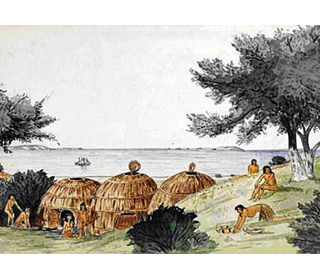Learn about the structure and the interior of the Grass House with pictures and images together with facts and information about the tribes who used them such as the Chumash, Pomo and the Wintun people. California Grass Mat House Definition
Definition: The California Grass House, or hut, was a shelter that was constructed using a domed wooden frame, typically made with willow poles, that were thatched with grass mats made from the stems of Tule (Southern Bulrush), Giant Wild Rye or Cattail that were abundant in California. Who lived in a Grass Mat House?
The Grass House was commonly used as a shelter and home by some of the Native Indian Tribes who inhabited coastal regions, rivers, lakes and wetlands where reeds and rushes grew in the present-day state of California. The names of the tribes who lived in the different grass mat style houses included the Chumash, Pomo and Wintun tribes of California. Other Types of Thatched Houses
The Caddo, Witchita and the Yucci tribes of the Southeast cultural group used thatch to build their distinctive 'Beehive' Grass Houses. Plateau tribes also used tule mats to build tepee-shaped Tule Mat Lodges. Californian Tribes Grass House Materials: Tule, Giant Wild Rye and Cattail
The reeds and rushes used to build the Californian grass houses were Tule, Giant Wild Rye and Cattail. The Common Tule (Schoenoplectus acutus var. occidentalis) also known as the Hardstem Bulrush is found in California. It has a thick, round green stem that grows between 3 - 10 ft (1 to 3 m) tall with long, grass-like leaves and pale brownish flowers. The stem of the tule is the part of the plant used in making the thatch for the grass house. Tules once lined the shores of Tulare Lake, California, which was once the largest freshwater lake in the western United States. Giant Wild Rye (Leymus condensatus) is a bunch grass that stays green all year and grows 5 to 10 feet (1.5–3 m) tall in the California oak woodlands. Cattails (Typha) are 5 to 10 feet (1.5–3 m) tall have spearlike long leaves and grows throughout California. How was a Grass House built?
The process and method to build a typical Grass House was as follows: - The building of the grass house was planned well in advance and required cooperation for collecting the building materials including the timber to build the framework of poles and gathering the reeds and rushes
- The slender poles were cut and stripped of branches and bark
- A circle was marked out and holes were dug about 20-30 inches (51 to 76 cm) apart where the framework poles were placed
- The circular willow framework that measured about 7 - 10 feet in diameter and about 7 feet high was built
- The women harvested the long green stems of tule (bulrush), Cattail or Giant Wild Rye which were dried over several weeks
- After the grass stems had dried, the women weaved and sewed the rushes into rectangular mats about 2 feet wide
- The grass mats were sewn together with dogbane (Indian hemp) and tied to the willow frame
How was the thatch made?
The process for making the thatch for a Grass House was as follows:- The stems of the grasses were used for the thatch. Leaves were stripped from the stems
- The stems were cut to a consistent size and tied in bundles
- The thatching work was done in pairs, one person on the outside of the framework, the other person on the inside
- The person on the outside of the frame put a bundle of thatch into place.
- A 2 feet long wooden 'needle', containing cordage made from dogbane (Indian hemp), was passed to the inside person that secured and tied the bundle into place
- The thatch was neatly trimmed and evened with the use of a paddle
- The process continued as layers of grass thatch were uniformly placed over the whole of the framework creating the circular shape
- The apex was left open to form the smoke hole and space was left for the doorway. There were no windows in a beehive house
- An opening in the roof created a smoke hole which could be covered with a thatch flap.
- The doorway had an entrance flap made from a thatched mat. The doors of the Californian grass houses always faced towards the east and were built near water
|
